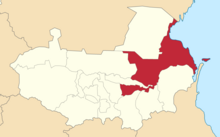|
Kizlyarsky otdel
The Kizlyarsky otdel[a] was a Cossack district (otdel) of the Terek oblast of the Caucasus Viceroyalty of the Russian Empire. The area of the Kizlyarsky otdel makes up part of the North Caucasian Federal District of Russia. The district was eponymously named for its administrative center, Kizlyar.[2][page needed] Administrative divisionsThe subcounties (uchastoks) of the Kizlyarsky otdel were as follows:[3]
DemographicsRussian Empire CensusAccording to the Russian Empire Census, the Kizlyarsky otdel had a population of 102,395 on 28 January [O.S. 15 January] 1897, including 53,605 men and 48,790 women. The majority of the population indicated Russian to be their mother tongue, with a significant Nogai speaking minority.[4]
Kavkazskiy kalendarAccording to the 1917 publication of Kavkazskiy kalendar, the Kizlyarsky otdel had a population of 136,749 on 14 January [O.S. 1 January] 1916, including 71,901 men and 64,848 women, 119,287 of whom were the permanent population, and 17,462 were temporary residents:[7]
Notes
References
Bibliography
|
|||||||||||||||||||||||||||||||||||||||||||||||||||||||||||||||||||||||||||||||||||||||||||||||||||||||||||||||||||||||||||||||||||||||||||||||||||||||||||||||||||||||||||||||||||||||||||||||||||||||||||||||||||
